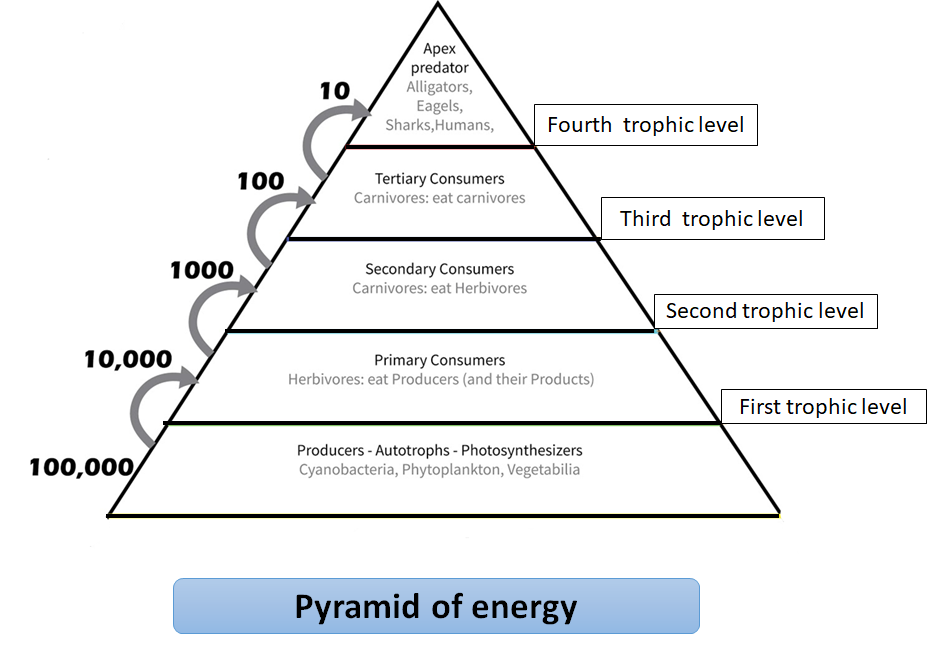
Explain energy flow in the ecosystem.
Answer
574.2k+ views
Hint: The energy will move from the lowest trophic level to the highest trophic level. The lowest trophic level (i.e., primary producers/green plants) have the maximum energy and the highest trophic (apex consumers) level has the least energy.
Complete step by step answer:
Energy flow is always unidirectional. The ecosystem functions by cycling the nutrients and the energy exerted from different sources.
The producers as well as consumers are organized into various feeding categories called trophic levels. The energy obtained from the food is passed from one trophic level to the next trophic level with the food chain. The transfer of energy between two trophic levels will depend upon the two laws of thermodynamics.
- $1^{st}$ thermodynamics law: Energy can neither be created nor it can be destroyed, it can change from one form to another.
- $2^{nd}$ law of thermodynamics: Energy is transferred and lots of energy gets wasted.
The primary source of energy for almost every living thing on the earth is the solar energy obtained from the sun. The maximum radiation of the sun is reflected by the earth’s atmosphere to space and this efficacious energy is called photosynthetically active radiation (PAR). Plants will utilize 2- 10% of this PAR to perform photosynthesis. This smaller quantity of energy endures all life forms on this earth. The energy flow between various life forms occurs via the food chain and food web.

The green plants are called primary producers in the ecosystem. These green plants absorb sunlight and convert a small amount of this sunlight into chemical energy by photosynthesis. The energy obtained by the plants is transferred to the primary consumers. Primary consumers are herbivorous animals and they feed on various plant parts for its survival. Primary consumers translate the chemical energy stored on various plant parts into kinetic energy. Energy degradation occurs through the transformation of energy into heat. The herbivorous animals are consumed by the secondary consumers and further degradation of energy occurs. Secondary consumers are carnivorous animals. The degradation of energy further ensues when these secondary consumers are consumed by the tertiary consumers.
Note: From one trophic level to the next trophic level only 10% of energy will be transferred and 90% of the energy gets lost. This is called the 10 percent law. For instance, if the primary producers have 100% energy then the primary consumers will receive only 10% energy. In this way, the apex predators will receive only 0.1% of the energy. The rest amount of the energy will be released into the atmosphere in the form of the heat.
Complete step by step answer:
Energy flow is always unidirectional. The ecosystem functions by cycling the nutrients and the energy exerted from different sources.
The producers as well as consumers are organized into various feeding categories called trophic levels. The energy obtained from the food is passed from one trophic level to the next trophic level with the food chain. The transfer of energy between two trophic levels will depend upon the two laws of thermodynamics.
- $1^{st}$ thermodynamics law: Energy can neither be created nor it can be destroyed, it can change from one form to another.
- $2^{nd}$ law of thermodynamics: Energy is transferred and lots of energy gets wasted.
The primary source of energy for almost every living thing on the earth is the solar energy obtained from the sun. The maximum radiation of the sun is reflected by the earth’s atmosphere to space and this efficacious energy is called photosynthetically active radiation (PAR). Plants will utilize 2- 10% of this PAR to perform photosynthesis. This smaller quantity of energy endures all life forms on this earth. The energy flow between various life forms occurs via the food chain and food web.

The green plants are called primary producers in the ecosystem. These green plants absorb sunlight and convert a small amount of this sunlight into chemical energy by photosynthesis. The energy obtained by the plants is transferred to the primary consumers. Primary consumers are herbivorous animals and they feed on various plant parts for its survival. Primary consumers translate the chemical energy stored on various plant parts into kinetic energy. Energy degradation occurs through the transformation of energy into heat. The herbivorous animals are consumed by the secondary consumers and further degradation of energy occurs. Secondary consumers are carnivorous animals. The degradation of energy further ensues when these secondary consumers are consumed by the tertiary consumers.
Note: From one trophic level to the next trophic level only 10% of energy will be transferred and 90% of the energy gets lost. This is called the 10 percent law. For instance, if the primary producers have 100% energy then the primary consumers will receive only 10% energy. In this way, the apex predators will receive only 0.1% of the energy. The rest amount of the energy will be released into the atmosphere in the form of the heat.
Recently Updated Pages
Master Class 12 Business Studies: Engaging Questions & Answers for Success

Master Class 12 Economics: Engaging Questions & Answers for Success

Master Class 12 English: Engaging Questions & Answers for Success

Master Class 12 Maths: Engaging Questions & Answers for Success

Master Class 12 Social Science: Engaging Questions & Answers for Success

Master Class 12 Chemistry: Engaging Questions & Answers for Success

Trending doubts
What are the major means of transport Explain each class 12 social science CBSE

Which are the Top 10 Largest Countries of the World?

Draw a labelled sketch of the human eye class 12 physics CBSE

Explain sex determination in humans with line diag class 12 biology CBSE

The pH of the pancreatic juice is A 64 B 86 C 120 D class 12 biology CBSE

Give 10 examples of unisexual and bisexual flowers




